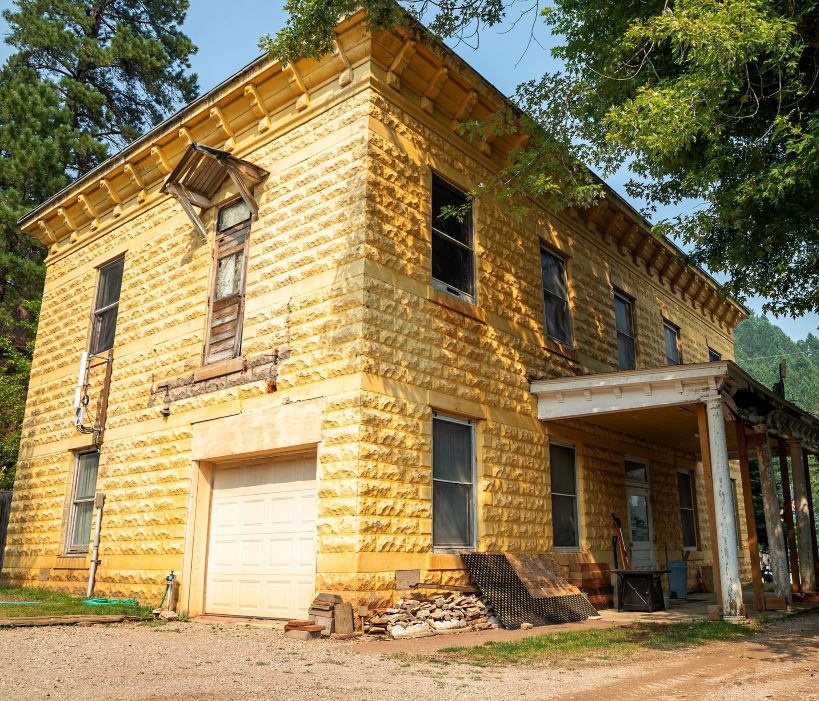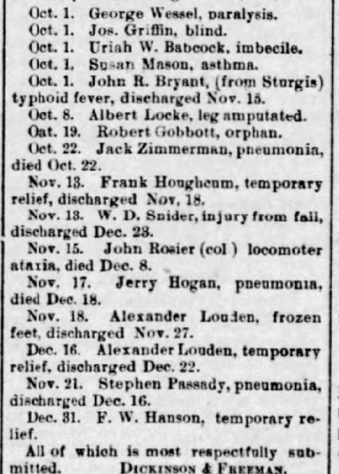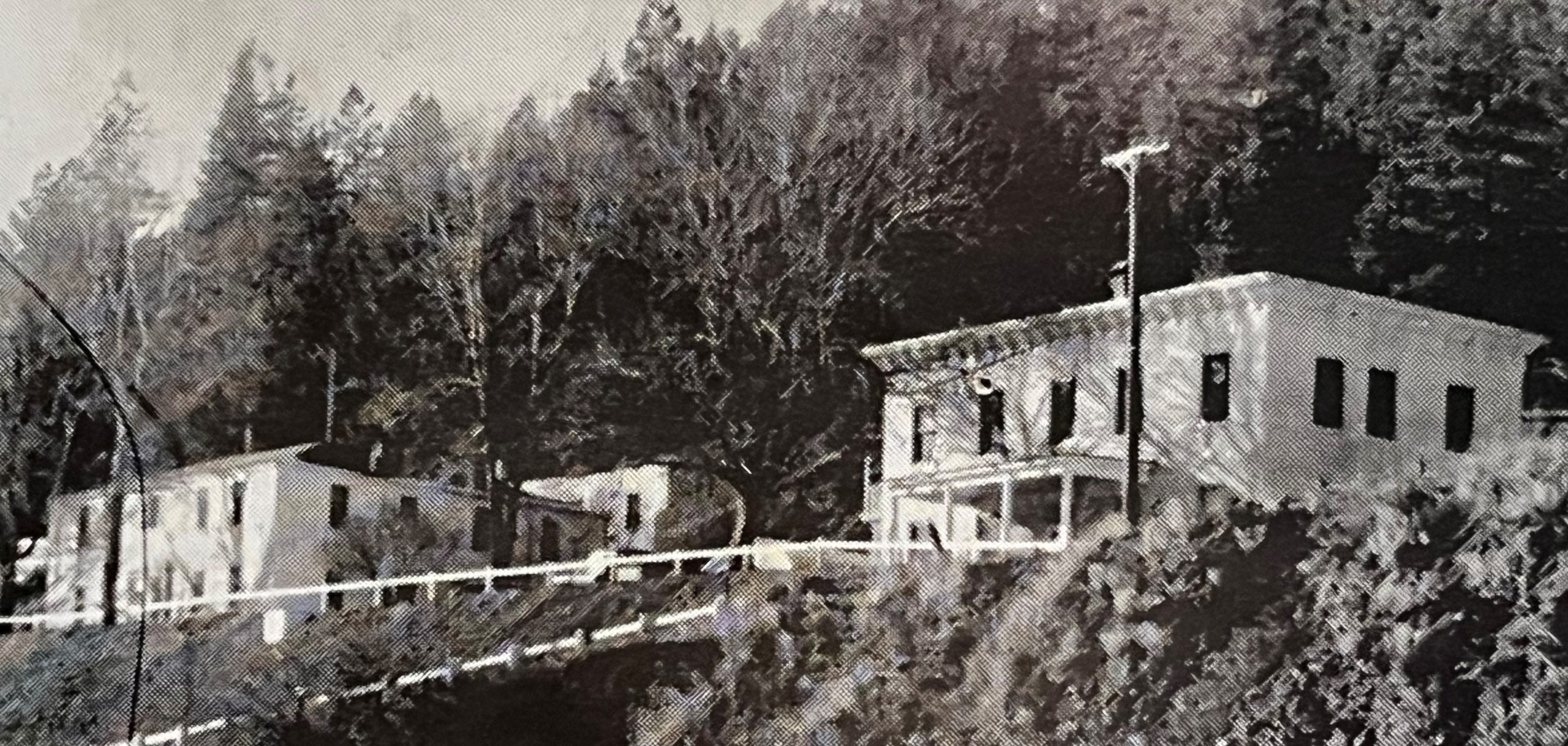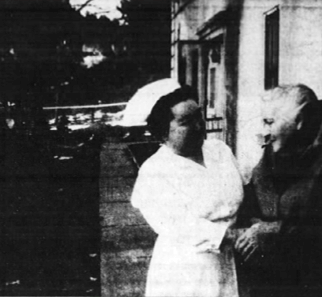Lawrence County Hospital and Poor Farm
Near the first discovery of gold in the Black Hills of South Dakota sits one of the most historic places in the Black Hills.
Gold was struck near where the former County Hospital Poor Farm was located. A number of people claimed that they discovered gold along Deadwood Creek and it was a meeting between the teams led by Frank Bryant and Bill Gay to settle the question. The agreement forged between the two parties was to give Bill Gay’s team “discovery” on Deadwood Creek if Bryant’s team was granted “discovery” on Whitewood creek. That was acceptable to both parties, subsequently “discovery” was established 900 feet downstream from Bill Gay’s No. 4 claim. Discovery now became just one claim below John Allen’s placer claim.
Timeline
1888
Lawrence county purchased the home of John Allen, located at “Number five above discovery” for $3,000. It had been a boarding house, and only need minor renovations. One room became the men’s dormitory and the second room became the dining room and kitchen. When the hospital opened its doors, there were nine inmates. The property consisted of 20 acres and two were planted that year. It allowed the hospital to develop revenues to help reduce expenditures. The newspapers noted that this “truck farm” produced roughly $200 in its first year. Production included raspberries, plums, strawberries, potato, tomato and onions.

1909
The county submitted a bid to build a new infirmary hoping that it would cost less than $12,000. The winning bid was given to George Morthland, supervisor of Homestake’s construction and water department. Mr. Morthland, using his architectural skills, designed the 52×32 foot hospital, and used Mullen & Rourke with their 50 men team to build the new men’s ward. When the hospital opened, there were 34 residents at the hospital, of which four were women. The four women were sent to the John W. Allen Victorian home located 50 to 90 feet from the men’s ward.
1930s
During the depression years of the ‘30s, 52 babies were born at the hospital. Mothers who were unable to pay the expense of a regular hospital came to the county hospital to give birth.
1940s
In the second story of the women’s ward building there was a complete family living apartment. This was occupied by the cook. It had some furniture and new linoleum was laid on the floor.

1953
Poor Farm officially becomes Lawrence County Hospital.

1957
The County Hospital was sold to a private nursing home association and renamed Hillcrest Home for the Aged.

1966
Hillcrest Manor was closed.

1971
The property was purchased by the KOA and has been a campground ever since. The annex was torn down and the only remaining building is the men’s infirmary built in 1909.

Men’s infirmary in 2023.
Notable Characters
William McKay
Along with H. N. Ross discovered gold on French Creek during Custer Expedition (1874)
“W. T. McKay died recently at the county hospital in Deadwood” DeSmet Leader 1884. The Kimball Enterprise newspaper wrote: “W. T. McKay, one of the pioneers of Bismarck and at one time a representative of this district in the territorial legislature, recently died in Deadwood.”
He also discovered the hot springs near Hot Springs SD. He brokered the sale in 1882, and then secured a homestead on a quarter section that contained hot springs. This happened before the sale consummated, and subsequently went to court. “McKay is a stayer, and will stay with the doctors until the last legal resource is exhausted.”
He was born in 1829 at New York, and moved to Canada with his parents. The newspapers wrote {although he never became handsome, he became of statue sufficient to clerk in a store” In 1849 he left for California, but got no further than Howard county Missouri. He became a wagon master, and in 1852 went across the plains making his way to California. It was there that he made sufficient money and had accumulated $20,000. He entered the stock brokerage business. In 1864 he sold his business, and left for Montana. His desire was to become a Morman and have multiple wives, but was unsuccessful to “get one wife.” He stayed in Virginia City prospecting until 1866. He was appointed a post trader at the Spotted Tail agency where he met up with Indians who claimed they had gold nuggets from the Black Hills. He immediately knew it wasn’t real, and had been taken from some “Montana miner that they had murdered.” In 1874, they joined up with General Custer and left Ft. Washington with his partner H. N. Ross.
Thomas E. Carey
He was first to establish presence of gold in Northern Black Hills and first to discover placer gold in Lead (February 1876). He built the first cabin in Lead near where gold run creek flows into Whitewood creek (near where Homestake mine was located). Later he built a new home at Golden Gate. Thomas was the second Superintendent of County Hospital.
George Wessell
Mr. Wessell was a native of Germany and died in 1890 at the age of 68. He received an excellent education in Germany where his father was a prominent burgher (lawyer). He came to America in 1850 when the desire to see “great lands beyond the sea” seized him at the age of 18. He went to Colorado in 1859, one of the first in the territory. Later he was one of the first to reside in Montana in 1861, and upon hearing of gold in the Black Hills, came here in 1876. In 1879, while sinking a shaft, he was stricken with paralysis, and sent to the poor farm.
He found fortune several times. He was known to find gold in German Gulch in Montana. It was said that he found fortune “more than once” and “distributed with a lavish generosity”.
Ambrose Lester
Ambrose came from Cheyenne in the early days and was a well known and well liked who served in the union army during the “war of the rebellion”. He was considered a favorite among the residents of Lead, and the children loved him. He had a good word for everyone. He was one of the most generous of men and gave financial and other aid to early prospectors. He was also a charter member of the Black Hills Pioneer Association. He was in the county hospital in 1906, but it was not the first time he was an inmate at the hospital. In 1902, he was sent to the hospital for several weeks with smallpox and reported dead several times but was soon seen on the streets “younger and healthier than before.”
In 1905, he was sent to the solders home in Hot Springs. He was an old man, having been a slave since before the Civil War. He can neither read or write, and didi’t know his age. According to the Daily Deadwood Pioneer Times in 1905, he “has a heart as big as a mountain”.
Cranky Johnny (John Thornton)
John Thornton died in the county hospital in 1918 at the age of 45 due to leakage of the heart and congestion of the lungs forming a combination against which his strength could not fight. He was a constant sufferer for years and was of an unusually reticent disposition and on, account of his eccentricities, was familiarity called by his many friends, “Cranky Johnny.”
Rev. Archibald
He came to the Black Hills in the 80s, and became pastor of the Baptist Church in Lead in the 90s. In addition to his ministerial duties, he was one of the foremost architects in Lead and surrounding communities in the Black Hills. He left Lead for a short time, and upon his arrival was assigned a supervisor position with Homestake by his good friend, Thomas Grier. Rev. Archibald married Mr. Grier to Ms. Palethorpe in the Baptist parsonage in 1898. Among his projects included the Halloran Block and the Ed Donaldson mansion in Lead. Mr. Archibald became an inmate at the county hospital because of mental breakdown following his divorce, and made the news after he escaped the county hospital. They found him making his way to Dumont. He came from Canada originally and passed away in his Lead residence in 1929 at the age of 74.
Hannah Matson
In 1897, Sheriff McDoandl put Mrs. Matson of Terraville, an insane patient, into a straight jacket because she, “became so violent the attendants were afraid of her.” She appears in the newspapers again in 1897. Her husband, Gus Matson, filed a complaint againt Hannah, charging her with insanity. She hallucinates according to Gus, particularly on the subject of religion of which she talks about it constantly. She imagines she is going to heaven, and is “radically irrational”.

CONTACT
Lead Historic Preservation
Lead City Hall
801 W Main St
Lead, SD 57754
(605) 581-1401





